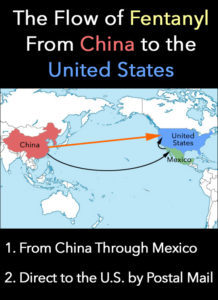
written for Inspire Malibu
At the end of January 2019, officials at the U.S. Customs and Border Protection declared a seizure of fentanyl powder and pills – 254 pounds in total – the largest in history. It was enough of the deadly synthetic opioid to kill an estimated 100 million Americans. The haul came through Mexico, in a truck packed with cucumbers, but the fentanyl shipment began its journey in China.
“The rise of fentanyl in the United States can be traced back to China’s large chemical and pharmaceutical industries, which manufacture vast quantities of the drug and its analogues to export to the western hemisphere with little regulatory oversight,” reports the U.S. China Economic and Security Review Commission.
The result for Americans is deadly. In 2017, an estimated 70,000 people died from drug overdoses. Even more stark is more than 28,000 of those deaths were fentanyl related, according to the National Institute on Drug Abuse (NIDA).
Here are just a few of the deadly facts about fentanyl:
- Fentanyl is 100 times more powerful than morphine
- Just 2 milligrams of fentanyl powders can be fatal. It’s so dangerous that first responders often wear gloves and masks to avoid skin contact or breathing in the deadly particles
- The drug is so cheap, drug dealers often cut drugs like cocaine with fentanyl or put it in the party drug MDMA, making it difficult for first responders to accurately diagnose what drug a person has overdosed on
- Law enforcement has also discovered pill being sold on the street that are fentanyl disguised to look like Xanax and the opioid painkiller Norco
There are two ways illegal fentanyl from China makes its way into the country. One is through Mexico, where traffickers can use any number legal border crossings to conceal and smuggle the drugs in. Another option for overseas laboratories that deal in fentanyl is simply the international mail, through the U.S. Post Office.
According to its own statistics, the U.S. Postal Service handles 47 percent of world’s mail. That kind of volume makes it near impossible to scan every piece of international mail for drugs like fentanyl, which are easily concealed.
In 2018, Senate investigators conducted an experiment. They contacted websites they found on Google that claimed to sell fentanyl. There were six websites in total, all of them located in China.
“All of the international online sellers who corresponded with the [Senate] Subcommittee expressed confidence that the drug products they advertised would get delivered to the United States and not seized by any customs authorities,” reports the Daily Dayton News.
Ohio was among the four states that had the highest rate of transactions with the six online fentanyl-related websites identified by Senate investigators. Florida, Pennsylvania and New York also made that list.
The People’s Republic of China controls an estimated 40 percent of the global market for pharmaceutical ingredients. However, the Chinese Government does little to regulate this billion-dollar industry and rarely enforces what few laws it has on the books. There are many competing opinions about why China has done little to nothing to stop the influx of fentanyl.
One argument has a historical context. Some 200 hundred years ago, China was flooded with Turkish and Indian opium, brought in and sold by British and American traders. Emperor Yongzheng outlawed the sale of opium in 1729, but when that failed to slow the trade, western sellers told the government they first had to stop demand for the product.
That argument, however simplistic, echoes some of the Chinese government’s sentiment toward North America’s current opioid epidemic. Another reason it’s difficult to stop fentanyl from being smuggled into the U.S. has to do with the Chinese economy.
“If given the choice between shuttering a profit-making narcotics syndicate and forgoing tax revenue and jobs or letting it slide, many officials in China choose to let [the illegal sale of fentanyl] slide,” writes Washington Post op-ed contributor John Pomfret.
Despite the 254-pound seizure earlier this year, experts are scrambling to come up with physical, technological and political solutions to the scourge of fentanyl in the U.S. In the meantime, fentanyl-related deaths, according to the most recent data, have increased by 45 percent. There are few signs of these fatalities slowing.
